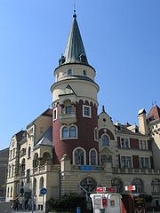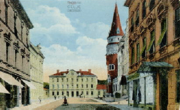
Celje Hall
Encyclopedia

Celje
Celje is a typical Central European town and the third largest town in Slovenia. It is a regional center of Lower Styria and the administrative seat of the Urban Municipality of Celje . The town of Celje is located under Upper Celje Castle at the confluence of the Savinja, Ložnica, and Voglajna...
, Slovenia
Slovenia
Slovenia , officially the Republic of Slovenia , is a country in Central and Southeastern Europe touching the Alps and bordering the Mediterranean. Slovenia borders Italy to the west, Croatia to the south and east, Hungary to the northeast, and Austria to the north, and also has a small portion of...
.
Overview
It was built in an eclectic style by the VienneseVienna
Vienna is the capital and largest city of the Republic of Austria and one of the nine states of Austria. Vienna is Austria's primary city, with a population of about 1.723 million , and is by far the largest city in Austria, as well as its cultural, economic, and political centre...
architect Peter Paul Brang
Peter Paul Brang
Peter Paul Brang was a Viennese architect who worked in what are today the Czech Republic and Slovenia, as well as in Bulgaria and Romania....
between 1905 and 1906 as the main seat of ethnic German
Ethnic German
Ethnic Germans historically also ), also collectively referred to as the German diaspora, refers to people who are of German ethnicity. Many are not born in Europe or in the modern-day state of Germany or hold German citizenship...
associations in town. At such, it was intended to contrast with the Slovenian Community Center (Sln. Narodni dom), which had a similar function for the local Slovenes. The building's original name was the "German Center" (German
German language
German is a West Germanic language, related to and classified alongside English and Dutch. With an estimated 90 – 98 million native speakers, German is one of the world's major languages and is the most widely-spoken first language in the European Union....
Deutsches Haus) and it was used as the main community center for the purposes of the local German-speaking population and by those that identified with German culture
Culture of Germany
German culture began long before the rise of Germany as a nation-state and spanned the entire German-speaking world. From its roots, culture in Germany has been shaped by major intellectual and popular currents in Europe, both religious and secular...
.

Austria-Hungary
Austria-Hungary , more formally known as the Kingdoms and Lands Represented in the Imperial Council and the Lands of the Holy Hungarian Crown of Saint Stephen, was a constitutional monarchic union between the crowns of the Austrian Empire and the Kingdom of Hungary in...
, the building was confiscated from the German community by the new Yugoslav authorities and renamed the "Celje Hall." Several cultural associations were placed in the building, including the prestigious Hermagoras Society publishing house, which had been expelled from its original location in Klagenfurt
Klagenfurt
-Name:Carinthia's eminent linguists Primus Lessiak and Eberhard Kranzmayer assumed that the city's name, which literally translates as "ford of lament" or "ford of complaints", had something to do with the superstitious thought that fateful fairies or demons tend to live around treacherous waters...
, Austria
Austria
Austria , officially the Republic of Austria , is a landlocked country of roughly 8.4 million people in Central Europe. It is bordered by the Czech Republic and Germany to the north, Slovakia and Hungary to the east, Slovenia and Italy to the south, and Switzerland and Liechtenstein to the...
, after the Carinthian Plebiscite
Carinthian Plebiscite
The Carinthian Plebiscite on 10 October 1920 determined the final southern border between the Republic of Austria and the newly formed Kingdom of Serbs, Croats and Slovenes after World War I.- History :...
. Throughout the period of the Kingdom of Yugoslavia
Kingdom of Yugoslavia
The Kingdom of Yugoslavia was a state stretching from the Western Balkans to Central Europe which existed during the often-tumultuous interwar era of 1918–1941...
, the German community tried to get back the property and the building, but they were unsuccessful. After the Nazi German
Nazi Germany
Nazi Germany , also known as the Third Reich , but officially called German Reich from 1933 to 1943 and Greater German Reich from 26 June 1943 onward, is the name commonly used to refer to the state of Germany from 1933 to 1945, when it was a totalitarian dictatorship ruled by...
occupation of northern Slovenia and Lower Styria
Lower Styria
Lower Styria or Slovenian Styria is a traditional region in northeastern Slovenia, comprising the southern third of the former Duchy of Styria. The population of Lower Styria in its historical boundaries amounts to around 705,000 inhabitants, or 34.5% of the population of Slovenia...
in April 1941, the building was again restored to its former use. With the defeat of the Nazi regime in May 1945, most of the ethnic Germans fled the town together with the occupying German armed forces
Wehrmacht
The Wehrmacht – from , to defend and , the might/power) were the unified armed forces of Nazi Germany from 1935 to 1945. It consisted of the Heer , the Kriegsmarine and the Luftwaffe .-Origin and use of the term:...
, while the others were expelled by the Yugoslav Communist authorities. The building was again renamed the "Celje Hall."
Today it hosts several cultural associations and the town's tourist information centre, and is a venue for concerts and theatre.

